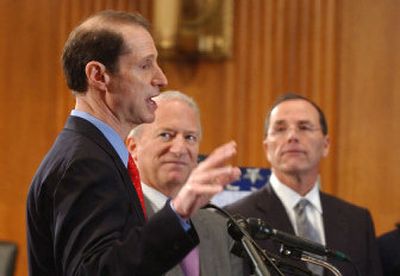Wyden unveils health care plan

WASHINGTON – In another sign that health care will return as a major issue when Democrats take over Congress next month, a prominent Democratic senator unveiled an ambitious proposal Wednesday to provide medical insurance for all Americans while also reining in costs.
The plan by Sen. Ron Wyden of Oregon comes a month after the health insurance industry offered its own comprehensive proposal and as politicians and the business community show new willingness to tackle a subject that has been off-limits since the mid-1990s collapse of President Clinton’s sweeping health-reform package.
Wyden, considered liberal on social issues and moderate on economic policy, combined elements of Democratic and Republican ideas in his health care plan. It would guarantee coverage for all – a Democratic objective. But it also would limit employers’ exposure to relentless cost increases and encourage workers to shop for cost-effective insurance plans – GOP goals.
“The last time America tried to fix health care was in 1993 and 1994 – since then, employer-based coverage has been melting away like a Popsicle in the sun,” Wyden said. “Business leaders in 1994 who said ‘We can’t afford to reform health care’ are now saying, ‘We can’t afford not to reform health care.’ “
Americans spend more than $2 trillion a year on health care – more per person than any other country. The returns on that investment are uneven, with many insured patients getting less than optimal care and millions of workers unable to afford health coverage, which costs about $12,000 to $13,000 a year for a family plan.
Employers traditionally have provided coverage for workers and their families as part of overall compensation. Although most workers still are insured through their jobs, corporate leaders are questioning whether the system can be sustained in an era of global competition and steadily rising costs.
Wyden’s plan would require employers to continue contributing toward the cost of health coverage, but it would get them out of the business of directly providing insurance and limit their exposure to double-digit annual inflation.
In the first two years of the plan, employers who now provide coverage would be required to directly pay workers what they were spending on insurance. Thereafter, most companies would pay the government a health care contribution resembling a payroll tax.
Using the money from their employers, individuals would be required to purchase private insurance policies through state purchasing pools. Benefits would be keyed to the Blue Cross Blue Shield Standard Plan available to federal workers. Workers would not have to pay higher income taxes because of the employer contribution.
The uninsured also would have to buy coverage, but premiums for the poor would be fully subsidized by the government, and middle-class families with incomes up to $80,000 for a family of four would be eligible for help on a sliding scale.
Premiums from individuals and contributions from employers would be collected by the government through the tax system and distributed to insurers. Once enrolled, individuals would be covered until retirement. Seniors in the Medicare program would not have to make changes.
An economic analysis by the Lewin Group consulting firm found that Wyden’s plan could be paid for with a little less than what the nation now spends on health care.
But Wyden’s proposal – spelled out in a 166-page bill that he plans to introduce soon – is complex, and such changes are not likely to be easily enacted. Most experts believe major health care reform will be possible only with the support of a president elected on a promise to tackle the problem.